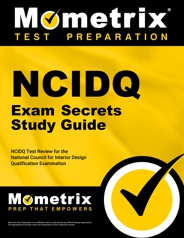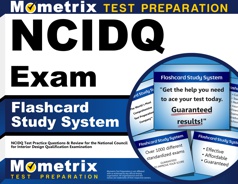The National Council for Interior Design Qualification (NCIDQ) exam is used as part of the certification process of interior designers, ensuring they are qualified and competent in protecting public health, safety, and welfare.
Click “Start Test” above to take a free NCIDQ practice exam!
NCIDQ Exam Eligibility
To be eligible to sit for the exam, you must meet the minimum education and experience requirements. You must have accrued at least 90 quarter credit hours (or 60 semester credit hours) in either interior design or architecture:
| Degree | Experience |
|---|---|
| Bachelor’s or master’s degree (CIDA or non-CIDA) | 3,520 work hours (2 years full-time) |
| Bachelor’s or master’s degree (other major) + interior design certificate, degree, or diploma | |
| Associate degree, certificate, or diploma | 5,280 work hours (3 years full-time) |
| Degree | Experience |
|---|---|
| Bachelor’s or master’s degree (NAAB or CACB) | 5,820 work hours (3 years full-time) |
| Bachelor’s or master’s degree (non-NAAB or non-CACB) | 7,040 work hours (4 years full-time) |
NCIDQ Exam Outline
The NCIDQ exam is split into three sections, which may be taken all at once or in separate testing sessions. The first two sections are made up of multiple-choice questions, while the third section contains alternative question types, such as fill-in-the-blank, hot spot, and drag-and-place.
| Section | Format | Questions | Time Limit |
|---|---|---|---|
| IDFXInterior Design Fundamentals Exam | Multiple-choice | 125 | 3 hours | IDPX Interior Design Professional Exam | Multiple-choice | 175 | 4 hours | PRACPracticum Exam | Fill-in-the-blank, hot spot, drag-and-place | 120 | 4 hours |
Each section is split into multiple content areas:
IDFX
The Interior Design Fundamentals Exam contains 125 multiple-choice questions and has a time limit of 3 hours. The exam is split into eight content areas:
I. Programming and Site Analysis (10%)
- Using analysis tools
- Context of the site
- Research methods
II. Relationship between Human Behavior and the Designed Environment (10%)
- Universal design
- Sensory considerations
- Human factors
- Contextual influence
III. Design Communication Techniques (10%)
- Conceptual diagrams
- Data and research
- Planning diagrams
IV. Life Safety and Universal Design (20%)
- Universal design
- Life safety
V. Interior Building Materials and Finishes (10%)
- Ceiling treatments
- Textiles
- Acoustical products
- Wall treatments
- Floor coverings
- Wayfinding and signage
- Window treatments
VI. Technical Specifications for Furniture, Fixtures, and Equipment and Lighting (15%)
- Sustainability and environmental impact
- Light fixture selection and specification
- Life safety elements
- Materials and technical specifications
VII. Construction Drawings, Schedules, and Specifications (20%)
- Construction drawing standards
- Power, data, and communication plans
- Demolition plans
- Millwork
- Appropriate measuring conventions
- Schedules
- Furniture plans
- Floor plans
- General information sheets
- Coding required information
- Elevations, sections, and details
- Finish plans
- Reflected ceiling/lighting plans
VIII. Professional Development and Ethics (5%)
- Professional ethics and development
IDPX
The Interior Design Professional Exam contains 175 multiple-choice questions and has a time limit of 4 hours. The exam is split into seven content areas:
I. Project Assessment and Sustainability (15%)
- Existing conditions analysis
- Square footage standards
- Project drivers
- Environmental and wellness attributes
II. Project Process, Roles, and Coordination (15%)
- Critical path
- Role of stakeholders
- Post-occupancy evaluation
- Allied professionals’ drawings
- Scope of project team members
- Project budgeting/tracking
- Phased construction plan
- Design phase criteria
- Specification types and format
III. Professional Business Practices (10%)
- Business management
- Proposals
- Scope of practice
- Contracts
- Business structures
- Project budgeting principles and practices
IV. Code Requirements, Laws, Standards, and Regulations (20%)
- Reference standards and guidelines
- Permit requirements
- Environmental regulations
- Zoning and building use
V. Integration with Building Systems and Construction (15%)
- Lighting systems
- Plumbing systems
- Installation methods
- Acoustical systems
- Structural systems
- Electrical systems
- Fire protection systems
- Building components
- Low voltage systems
- Vertical and horizontal transport systems
- Building construction types
- Monitoring systems
- Mechanical systems
VI. Integration of Furniture, Fixtures, and Equipment (10%)
- Cost estimations and budgeting
- Equipment integration
- Procurement, delivery, and installation processes
- Product components
- Paramaters of equipment maintenance
VII. Contract Administration (15%)
- Project meetings
- Construction mock-ups
- Project accounting
- Site visits and field reports
- Application of documentation and procedures
- Shop drawings and submittals
- Punch lists/deficiency list
PRAC
The Practicum Exam contains 120 Fill-in-the-blank, hot spot, and drag-and-place questions and has a time limit of 4 hours. The exam is split into four content areas:
I. Programming, Planning, and Analysis (15%)
- Universal design
- Planning diagrams
- Human factors
- Analysis tools
- Square footage standards
- Life safety standards and codes
- Existing conditions analysis
II. Code Requirements, Laws, Standards, and Regulations (30%)
- Reference guidelines and standards
- Universal design
- Life safety
- Zoning and building use requirements
- Permit requirements
III. Integration with Building Systems and Construction (25%)
- Building components
- Electrical systems
- Mechanical systems
- Fire protection systems
- Lighting systems
- Plumbing systems
- Acoustical systems
- Building construction types
- Vertical and horizontal transport systems
IV. Contract Documents (30%)
- Finish plans
- Allied professionals’ drawings
- Demolition plans
- Construction drawing standards
- Equipment integration
- Furniture plans
- General information sheets
- Phased construction plans
- Power, data, and communication plans
- Light fixture selection and specification
- Schedules
- Coding required information
- Measuring conventions
- Reflected ceiling/lighting plans
- Millwork
- Elevations, selections, and details
Check out Mometrix's NCIDQ Study Guide
Get practice questions, video tutorials, and detailed study lessons
Get Your Study Guide
NCIDQ Exam Registration
The NCIDQ exam is taken twice a year, in April and in October, with application deadlines in January and July.
During the application process, you will have to pay an application fee for the sections of the exam you are taking. To apply for all three at once, the fee is $225. To apply for them separately, it is $95 for the IDFX. After you have successfully passed this, you may apply and pay for the next two, at $145.
Once your application has been approved, you will receive an eligibility notification up to 6 weeks later letting you know how to schedule your exam(s).
Test Day
In-person Testing
On the day of your exam, you should arrive at the testing center about 30 minutes before the scheduled appointment to complete the check-in process. You will be asked to provide one form of valid, government-issued ID with a signature.
You will then be asked to place all personal items and electronic devices in a secure locker outside the testing area, and you may be asked to remove your eyeglasses and other accessories for a quick inspection.
For all three exams, you will be provided with an on-screen calculator, and you may request a hand-held calculator for the PRAC exam. You will also be given scratch paper for all three exams.
Once you have completed the pre-test procedures, you are directed to your testing station, and your test begins.
Remote Testing
You can sign into the test delivery platform 30 minutes before your appointment. You will need the confirmation number from the email you received after registering, and you must present one valid, government-issued ID with a signature to the proctor via your webcam. Your first and last name on the ID must match the first and last name you registered under.
All personal items and electronic devices must be removed from your testing area. An online scratchpad tool is provided in the test program for note-taking, and you will have access to an on-screen calculator for all three exams.
Before the exam begins, the proctor will ask you to scan your testing space using your webcam, to ensure there are no prohibited items. You may be asked to pull your hair back, roll your sleeves up and turn your pockets inside out.
Once the proctor is satisfied with your space and workstation and you have completed the pre-test activities, your exam begins.
How the NCIDQ Exam is Scored
Your NCIDQ score is based on the modified Angoff method and is solely determined based on your performance on the three exam sections. A passing score is determined by subject matter experts, who evaluate questions on the exam to establish a number of correct responses that would adequately demonstrate the required level of proficiency.
Since each version of the exam is different, the number of correct responses needed to obtain a passing score will vary slightly for each version. As such, your raw score (the number of questions you answered correctly) is converted to a scaled score for each exam section. To pass the NCIDQ exam, you must achieve a scaled score of at least 500 on each section.
Your score will be made available six weeks after testing. Your score report includes a pass/fail status, scaled score, and a breakdown of each section.
Retaking the NCIDQ Exam
If you did not pass the exam, you may retake any section of the exam as many times as it takes for you to pass.
Check out Mometrix's NCIDQ Flashcards
Get complex subjects broken down into easily understandable concepts
Get Your Flashcards
FAQs
Q
How many questions are on the NCIDQ exam?
A
There are 420 questions on the exam.
Q
How long is the NCIDQ exam?
A
The time limit for the all parts of the exam combined is 11 hours.
Q
What is the passing score for the NCIDQ exam?
A
To pass the exam, you must achieve a minimum scaled score of 500 on each section.
Q
What is the NCIDQ exam pass rate?
A
These are the pass rates for each section of the exam:
- IDFX: 48%
- IDPX: 58%
- PRAC: 65%
Q
How much does the NCIDQ exam cost?
A
The examination fee for the exam as a whole is $225.
